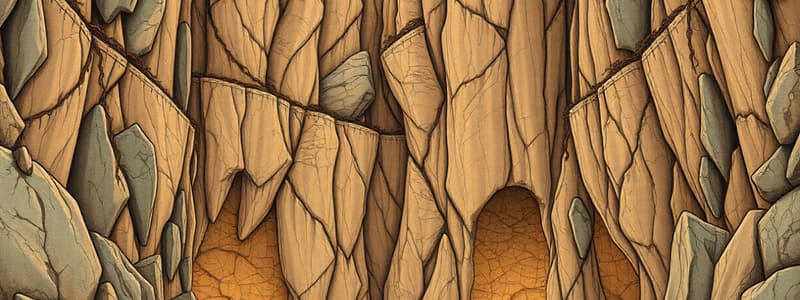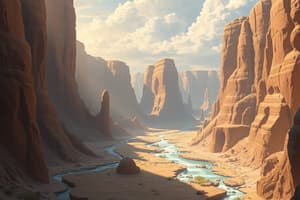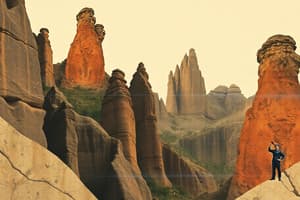Podcast
Questions and Answers
What is the primary focus of Historical Geology, as described?
What is the primary focus of Historical Geology, as described?
- Interpreting Earth's history through the study of rocks. (correct)
- Developing new methods for extracting resources from rocks.
- Predicting future geological events based on current trends.
- Classifying different types of rocks based on their mineral composition.
What characteristic of the limestone suggests it formed in calm water?
What characteristic of the limestone suggests it formed in calm water?
- The presence of quartz sand within the limestone.
- Its smooth, tan color that indicates the absence of impurities.
- The way it has lithified into rock.
- Its very fine grain size, which indicates it wasn't agitated by wind or currents. (correct)
What geological event is inferred from the presence of mud-chip clasts and quartz sand in the rock sample?
What geological event is inferred from the presence of mud-chip clasts and quartz sand in the rock sample?
- A volcanic eruption that deposited ash and debris.
- A period of gradual sediment accumulation over millions of years.
- A tectonic uplift that exposed deeply buried rocks to the surface.
- A high-energy event, such as a storm or hurricane, that fragmented and transported materials. (correct)
What process transformed the loose sediment of carbonate mud chunks and quartz sand into solid rock?
What process transformed the loose sediment of carbonate mud chunks and quartz sand into solid rock?
What does the author mean when using the phrase 'speak Rock'?
What does the author mean when using the phrase 'speak Rock'?
Flashcards
Storytelling
Storytelling
The art of conveying narratives through various mediums.
Historical Geology
Historical Geology
The study of Earth's history through its rock formations.
Limestone
Limestone
A sedimentary rock primarily composed of calcium carbonate from inorganic deposits.
Lithification
Lithification
Signup and view all the flashcards
Sedimentary Rock Formation
Sedimentary Rock Formation
Signup and view all the flashcards
Study Notes
Historical Geology: Decoding Earth's Story
- Earth's autobiography is written in rock formations
- Historical Geology deciphers this language
- Rocks, like the cobble from Montana, contain information about past processes and circumstances.
- Features like material variety, arrangement, fractures, and shape convey information
Decoding a Cobble
- Limestone formed from inorganic carbonate mud in calm water (fine grain size)
- Ripped-up mud chips and entombed in quartz sand indicate a storm (hurricane)
- Burial and compression lithified the material into rock (limestone clasts in quartz sandstone)
- Stress caused fractures, later healed by quartz veins (uplift)
- Differential weathering created the rock's texture
- Each stage of the rock's formation reveals a chapter in its story
Sequences of Strata
- Studying rock layers (strata) reveals shifts in depositional conditions
- Example: A transition from mud-rich to sand-rich layers in Chilean Patagonia shows changing water depth or tectonic activity.
- Hypotheses for such transitions are numerous, requiring further investigation
- Clues like mud chips, graded beds, fossil fauna shifts, or paleomagnetic inclination help determine the correct hypothesis
- Example: Japanese strata shows a shift from low to high oxygen levels, correlating with a mass extinction event (the End-Permian mass extinction).
Fossils as Time Markers
- Fossils, like words in an ancient language, mark specific times or places
- Different fossils are distinctive markers of particular periods
- Example: A particular fossil would not be found in unrelated time periods
- Fossils reveal information like the ages and depositional origins of sedimentary strata
- Fossils highlight unique changes through time
- Comparing layers with fossils helps interpret the depositional sequence
- Fossils are critical for constraining rock ages and deposition origin
Beyond Sedimentary Rocks
- Igneous and metamorphic rocks, and tectonic structures equally contribute to the Earth's story
- Igneous rocks, such as the lava flow at the Giant's Causeway, reveal cooling patterns and histories of volcanic activity (example: the North Atlantic Igneous Province)
- Igneous rocks showcase cooling and shrinking processes
- Metamorphic rocks, like blueschist, formed under intense pressure and heat in the Earth's interior—showcasing a transformation journey
Tectonic Structures as Scars
- Tectonic structures (folds, faults, shear zones) are also important clues in understanding geological history.
- These structures (as seen in the Andes) reveal how rocks deformed after original deposition-important clues to the history of the region
Earth's Story is Your Story
- Understanding Earth's history is essential because your body is composed of materials from the Earth itself
- Earth's processes (differentiation, mantle convection, volcanic eruptions, cometary impacts) are crucial for the existence of life and water
- The understanding of historical geology can enrich how people evaluate landscapes and appreciate the unique circumstances on the planet.
Studying That Suits You
Use AI to generate personalized quizzes and flashcards to suit your learning preferences.




